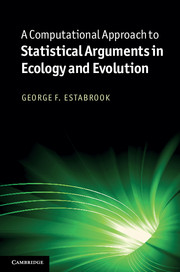Book contents
- Frontmatter
- Contents
- Acknowledgments
- 1 Introduction
- 2 Programming and statistical concepts
- 3 Choosing a test statistic
- 4 Random variables and distributions
- 5 More programming and statistical concepts
- 6 Parametric distributions
- 7 Linear model
- 8 Fitting distributions
- 9 Dependencies
- 10 How to get away with peeking at data
- 11 Contingency
- References
- Index
3 - Choosing a test statistic
Published online by Cambridge University Press: 05 June 2012
- Frontmatter
- Contents
- Acknowledgments
- 1 Introduction
- 2 Programming and statistical concepts
- 3 Choosing a test statistic
- 4 Random variables and distributions
- 5 More programming and statistical concepts
- 6 Parametric distributions
- 7 Linear model
- 8 Fitting distributions
- 9 Dependencies
- 10 How to get away with peeking at data
- 11 Contingency
- References
- Index
Summary
Data from fossil marine organisms
Raup and Sepkoski (1984a) published a study of the fossils of several hundred marine organisms that lived between about 300 million years ago and about 10 million years ago. They divided this time period into 43 stages of about seven and a half million years each. In each stage they counted the number of taxonomic families that made their last appearance in that stage (presuming that these families went extinct during that stage). Then they compared each pair of successive stages to determine if, from the earlier stage to its next later stage, the number of extinctions went up (U) or down (D). These are their observations:
UU DU DDDU DUUU DU DU DUU DDU DDUU DDDUU DDUUU DDUU DD
Each letter stands for a pair of successive stages. With 43 stages there are 42 pairs of successive stages, and hence 42 letters. An extinction peak occurred whenever a U was followed by a D. Observe that the lengths of the times, in units of stages, of inter-peak intervals are 2, 4, 4, 2, 2, 3, 3, 4, 5, 5, 4. The initial UU is not counted as an inter-peak interval because you cannot be sure when it began. Likewise, the final DD is not counted as an inter-peak interval because you cannot be sure when it ended. The average length of inter-peak interval is about 3 1/2 stages, which in units of years is about 26 MY. One group of scientists suggested that during this 290 MY period, the extinction rate of marine families had risen and fallen periodically, with a period of about 26 MY.
The controversy
A second group of scientists questioned whether the data support this hypothesis. They observed that half the pairs of successive stages showed an increase in extinction rate and half showed a decrease (there are 21 Us and 21 Ds) and so they hypothesized that with probability 1/2 the next successive stage shows an increase in extinction rate, and with probability 1/2 it shows a decrease. This hypothesis implies a non-periodic random process. They showed mathematically that this hypothesis predicts that the average inter-peak interval length approaches 4.0 as the sequence of Us and Ds becomes very long. They argued that this is close enough to the observed average of 3 1/2 to interpret the data as consistent with this hypothesized non-periodic random process.
- Type
- Chapter
- Information
- Publisher: Cambridge University PressPrint publication year: 2011

